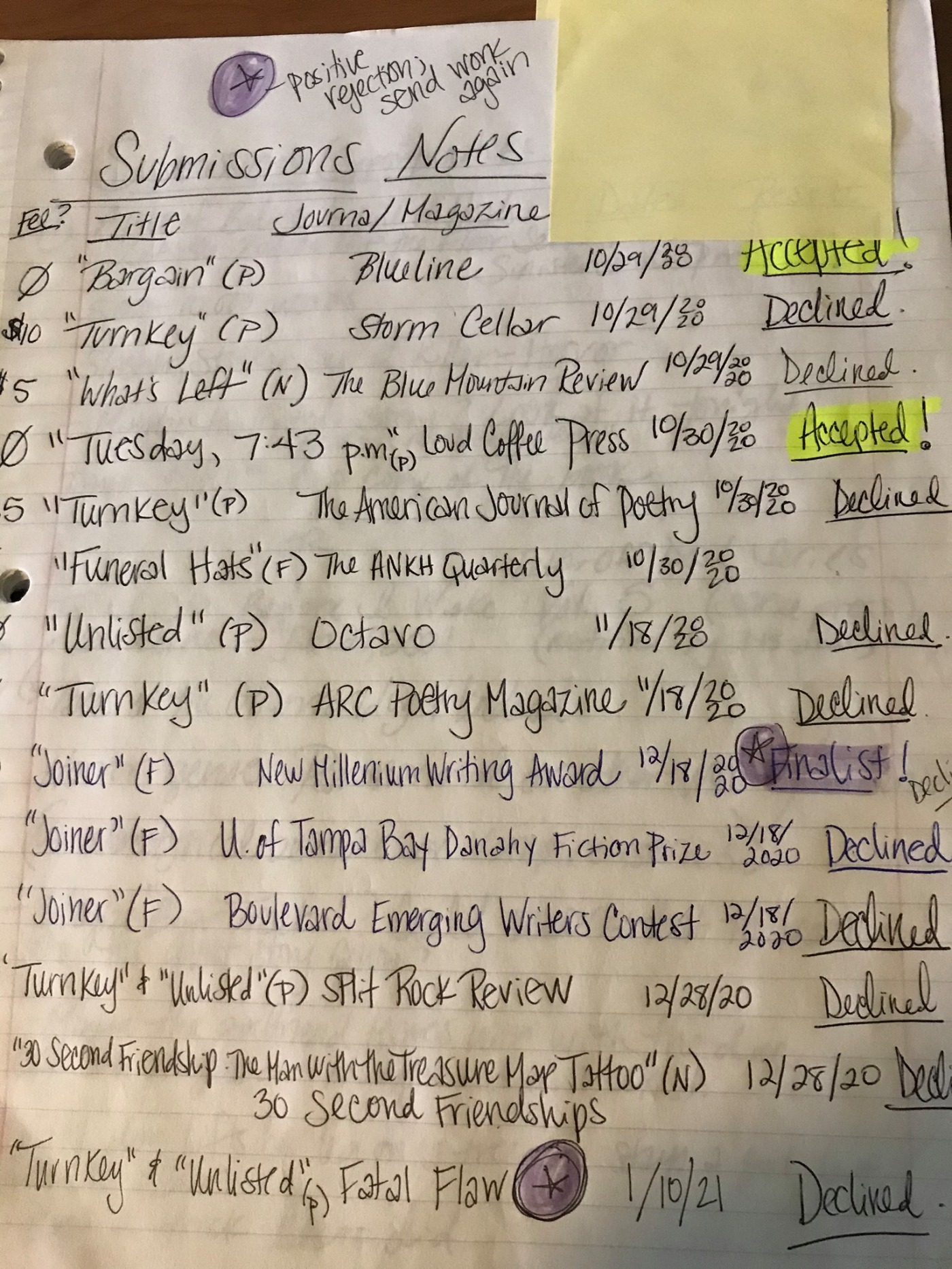Pic: This is how I keep track of submissions. Low tech but effective.
I have found, pretty recently, that being rejected as a writer is a skill. And like any skill, you can get better at it.
During lockdown, I got back to work on my own writing, spending more time and energy on it than I had in years. Instead of finding the creative well dry, as I had feared, a couple of stories seemed to write themselves. I joined four friends in a Zoom writing workshop (we still meet). I made appointments with an excellent editor-for-hire, and we’ll schedule another session soon. I wrote and I revised, and then I wrote some more. I went on a personal writers’ retreat, renting a cabin in the Catskills with my wonderful friend N. West Moss for a few days, and drafted two new stories. For a while there, I was kicking ass.
In that time period, I also got back to submitting my work to journals and magazines and writing contests. I realized that the process energizes me–everything sent out is a chance that it will find a place in the world. Submitting stories (and sometimes, essays and poems) makes the process more real for me–it makes me feel more like a “real” writer, whatever that is.
And wow, did those rejections roll in. And they keep rolling in. And honestly, yep, sometimes they stung, and sometimes they still do. But they sting less all the time. I shrug at them now, mostly. If I get two in a day, I laugh. It sucks, even now, if I get a rejection on a submission I thought was a good fit–like if my story matched the theme, or aligned with the goals of the publication.
A few came close. “Joiner,” a story, was a finalist in the New Millennium Writing Awards. A flash piece, “Rest for the Wicked,” got a lovely rejection from the Parsec Ink contest, saying it made the longlist. Fatal Flaw rejected two poems, but encouraged me to send more (I will!).
I’ve gotten acceptances, too. For the year of 2021, my record is 5 acceptances, 43 rejections, with a handful of submissions still out. Most recently, The Elpis Pages, a print collective (with profits going to Planned Parenthood), took my essay “What’s Left.” That will be out this month. Then, I got an email from Last Girls Club, saying my story wasn’t a fit for their magazine, but could they read it on their podcast, Blood & Jazz? (The answer of course was YES.)
A lot of what has gotten accepted from 2020-2021 had been in the works for a while. Like a long-ass time. A poem that Blueline Magazine took (“Bargain,”) had existed in various forms for over seven years. “Tourist,” a flash essay Anti-Heroin Chic published, was first drafted about three years ago. Every time those pieces (and others) got rejected, I would take another look at them. Tinker. Fiddle. Tighten them up. And, not surprisingly, they got better. And then they found homes.
I was inspired by the article “Why you should aim for 100 rejections a year” from LitHub by Kim Liao. I was also motivated by a Facebook thread posted by the editor of a small press, which turned into a big conversation about why women tend to submit less often than men. (Spoiler: it’s because patriarchy.) The main idea with both of those? Submit, submit, submit.
I look for opportunities on various Facebook pages, through Reedsy, Newpages, and Erica Verillo’s blog, Publishing and Other Forms of Insanity. I don’t mind submissions fees–publications are expensive to run and print, and need to pay for staff and software, etc.–but I don’t break the bank. I look for cheap and free submissions opportunities, too. I keep track of everything in a janky notebook–see photo. (I tried keeping a tidy Excel file, but that’s just not me–I’m a pen-and-paper gal at heart.)
In 2022, I hope to hit the 100 rejection mark. If I double my rejections, I might just double my acceptances, too. Who’s in?

It was my most successful year at being rejected and I think I may be up for doubling it next yeat
LikeLiked by 1 person
Yes! #100rejections
LikeLiked by 1 person
So much that has been published lately has existed for a long time, in ever-evolving forms. Keep going!
LikeLiked by 1 person